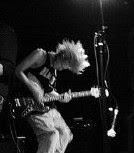Emo's, 9/4
Making yourself go see new music is a bit of a rhythm thing. Anna C. and I were pretty exhausted yesterday, and I don't think either one of us was really revved up to go to a show downtown. Somehow we went anyway. It's funny how these things work out -- we miraculously found a parking space about 7 blocks closer to Emo's than where we usually park when going to weekend Red River shows. And two bands for whom I didn't have particularly high expectations put on worthwhile shows.
She Sir has some burnishing left to do to make their live set equal to their ambitions, but even with mistakes you can hear elements in every song that show they are working hard on being original. Their principal lead singer has a tantalizing natural approach and the right sense of what notes to sing and when to place them to be heard clearly against the ringing, circling guitars. I could hear good ideas in their efforts at harmony but the parts seem works in progress. The instruments are tighter. Drummer David Nathan clearly divides one section from the last with good part choices. Guitarist Jeremy Cantrell plays hardly anything flashy but his figures are always clearly separate from the chiming quality of the bass and rhythm. Nathan and Cantrell's ability to accent in different places gives the band a more varied, warm quality than most of the Jesus and Mary Chain enthusiast groups in Austin.
Most of their songs do sort of follow the same template, but they kept giving me reasons to stay and watch the whole set. They rewarded my patience with a quiet, brooding number that replaced bass with shaker and had the guitars taking different roles. They are significantly tighter when the lead singer is not playing bass; he's not comfortable on the instrument yet and his tardy poking breaks the solid four-way communication She Sir has working when he's on guitar. Playing bass and singing is really hard.
Ringo Deathstarr are a band I'm glad I have a chance to write about because they do something unusual. I love to make broad generalizations and any guitarists who have talked to me at length know how much I dislike effects pedals. Most of the time, young guitar players use pedals as a substitute for coming up with distinctive parts. This is obvious when it happens and not a lot of fun to listen to. But there are exceptions to every rule. Ringo's Elliot Frazier is as effects-dependent as they come. Scales and arpeggios and syncopation aren't his style. But he uses effects really well; differently on each song and intelligently so that the rhythms created by the wave of the delay or flanger or phaser or whatever fits together in rhythm with the bass and drums. His playing isn't at all random and it's downright impressive how the trio can shift styles convincingly through slight changes in tempo and creative, practiced shifts in guitar sound.
The band benefits a lot from being able to switch back and forth from Frazier's lead vocals to Alex Gehring's. Neither is a real attention-getting singer but both are flattered by the way their dreamy, dazed approaches contrast each other. I also give Ringo Deathstarr a lot of credit for trying something really different in the middle of their set. Frazier turned his guitar volume down -- way down -- and played texture for a song that followed instead a simple loop played out of an iPod. Drummer Daniel Coborn did an admirable job of backing off and keeping the loop audible, and they did a haunting sort of Blonde Redhead number with effective chanteuse vocals from Gehring. When the drums suddenly swung back in mid-song to their usual powerful attack (BRMC, anybody?) it tied the departure back into the rest of the set. Very cool.
Ringo Deathstarr had another member until recently and is adjusting. Isn't it funny how many bands I see short a player that I end up really liking? Same thing happened with SuperLiteBike. I think it goes to show that coming up with the right parts for the instruments you have can be a quicker way of getting where you want to go than adding another musician. Losing a member and continuing to play shows often forces the musicians who remain in a band to reconsider how they approach the set. Can I play something differently? Can I make this part more exciting by waiting and coming in late, or moving it to a more unexpected place? When bands grow more creative through adversity you really learn a lot about their staying power, as a fan.
Anna C. did not care for She Sir. She has had her fill of four-guy guitar bands that sound sort of like Interpol. I try really hard to judge a band based on their own merits and not hold their entry into a locally-overexposed genre against them. In my opinion, She Sir might not have picked the most original combination of influences but they do a better job than many of taking their inspirations to cool places. I didn't think they were boring at all. Anna, not so much. She was more excited for Ringo Deathstarr, because she had seen them before and liked them. She was curious to hear my opinion, because by her own admission she wasn't sure whether she liked the band because they were good or because they had an integral female member, bassist/singer Gehring. Well, I think they're good too.

No comments:
Post a Comment